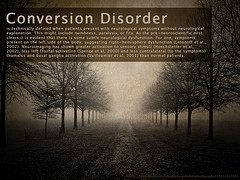“As an undergraduate student in psychology, I was taught that multiple personalities were a very rare and bizarre disorder. That is all that I was taught on ... It soon became apparent that what I had been taught was simply not true. Not only was I meeting people with multiplicity; these individuals entering my life were normal human beings with much to offer. They were simply people who had endured more than their share of pain in this life and were struggling to make sense of it.”
― Deborah Bray Haddock, The Dissociative Identity Disorder Sourcebook

Conversion Disorder
The DSM-5 gives the following criteria for a diagnosis of conversion disorder (functional neurological symptom disorder):
A. One or more symptoms of altered voluntary motor or sensory function.
B. Clinical findings provide evidence of incompatibility between the symptom and recognized neurological or medical conditions.
C. The symptom or deficit is not better explained by another medical or mental disorder.
D. The symptom or deficit causes clinically significant distress or impairment in social, occupational, or other important areas of functioning or warrants medical evaluation.
Coding note: The ICD-9-CM code for conversion disorder is 300.11, which is assigned regardless of the symptom type. The ICD-10-CM code depends on the symptom type (see below).
Specify symptom type:
(F44.4) With weakness or paralysis
(F44.4) With abnormal movement (e.g., tremor, dystonie movement, myoclonus, gait disorder)
(F44.4) With swallowing symptoms
(F44.4) With speech symptom (e.g., dysphonia, slurred speech)
(F44.5) With attacks or seizures
(F44.6) With anesthesia or sensory loss
(F44.6) With special sensory symptom (e.g., visual, olfactory, or hearing disturbance)
(F44.7) With mixed symptoms
Specify if:
Acute episode; Symptoms present for less than 6 months.
Persistent: Symptoms occurring for 6 months or more.
Specify if:
With psychological stressor (specify stressor)
Without psychological stressor (American Psychiatric Association, 2013)1.
Criterion A gives a basic descriptor of what category the possible symptoms fall under; that of altered voluntary motor or sensory function. What this includes is clarified under the specified symptom type. Examples of altered voluntary motor function include muscle weakness or paralysis, abnormal movements, abnormal walking style, and abnormal limb posturing. Examples of altered sensory function include "altered, absent, or reduced skin sensation, vision, or hearing." Conversion disorder can mimic seizures through psychogenic non-epileptic seizures (PNES) or can mimic a coma. It can cause "reduced or absent speech volume... altered articulation... a sensation of a lump in the throat...and [double vision]."
Criterion B specifies that the symptoms, though seemingly neurological in nature, are not actually caused by a neurological disease. Evidence must clearly support the absence of a neurological disease for this diagnosis to be made; not being able to diagnose a neurological condition or viewing symptoms as bizarre is not sufficient. Finding that symptoms are internally inconsistent is more indicative that a neurological cause is not to blame.
Criterion C specifies that if a symptom is due to another medical or mental disorder, it cannot be used to make a diagnosis of conversion disorder. It should be noted that it is possible for one to have a genuine neurological condition as well as conversion disorder that causes similar symptoms. For example, one could have both epileptic seizures and non-epileptic seizures.
Criterion D ensures that the symptom is sufficiently serious to warrant a diagnosis. It also ensures that symptoms that are due to cultural practices are not used for a diagnosis of conversion disorder.
Some features can support a diagnosis of conversion disorder. These include having experienced similar somatic symptoms in the past, onset associated with trauma, and symptom association with dissociative symptoms. However, it should be noted that while trauma, especially childhood trauma, is associated with conversion disorder, it is not necessary for a diagnosis, and maladaptive coping is a possible factor as well (American Psychiatric Association, 2013).1
Transient conversion symptoms are common, though persistent conversion symptoms are far less so. Approximately 5% of referrals to neurology clinics are due to conversion disorder. Though onset can begin at any age, certain specific symptoms (such as non-epileptic seizures and motor symptoms) are more likely to begin in one's 30s or 40s. Conversion disorder is more common in females (American Psychiatric Association, 2013).1
Conversion disorder should be differentiated from neurological diseases, somatic symptom disorder, factitious disorder and malingering, dissociative disorders, body dysmorphic disorder, depressive disorders, and panic disorders, though comorbidity is also possible or even common (American Psychiatric Association, 2013).1
1 American Psychiatric Association. (2013). Somatic Symptom and Related Disorders. In Diagnostic and statistical manual of mental disorders (5th ed.). http://dx.doi.org/10.1176/appi.books.9780890425596.dsm09
